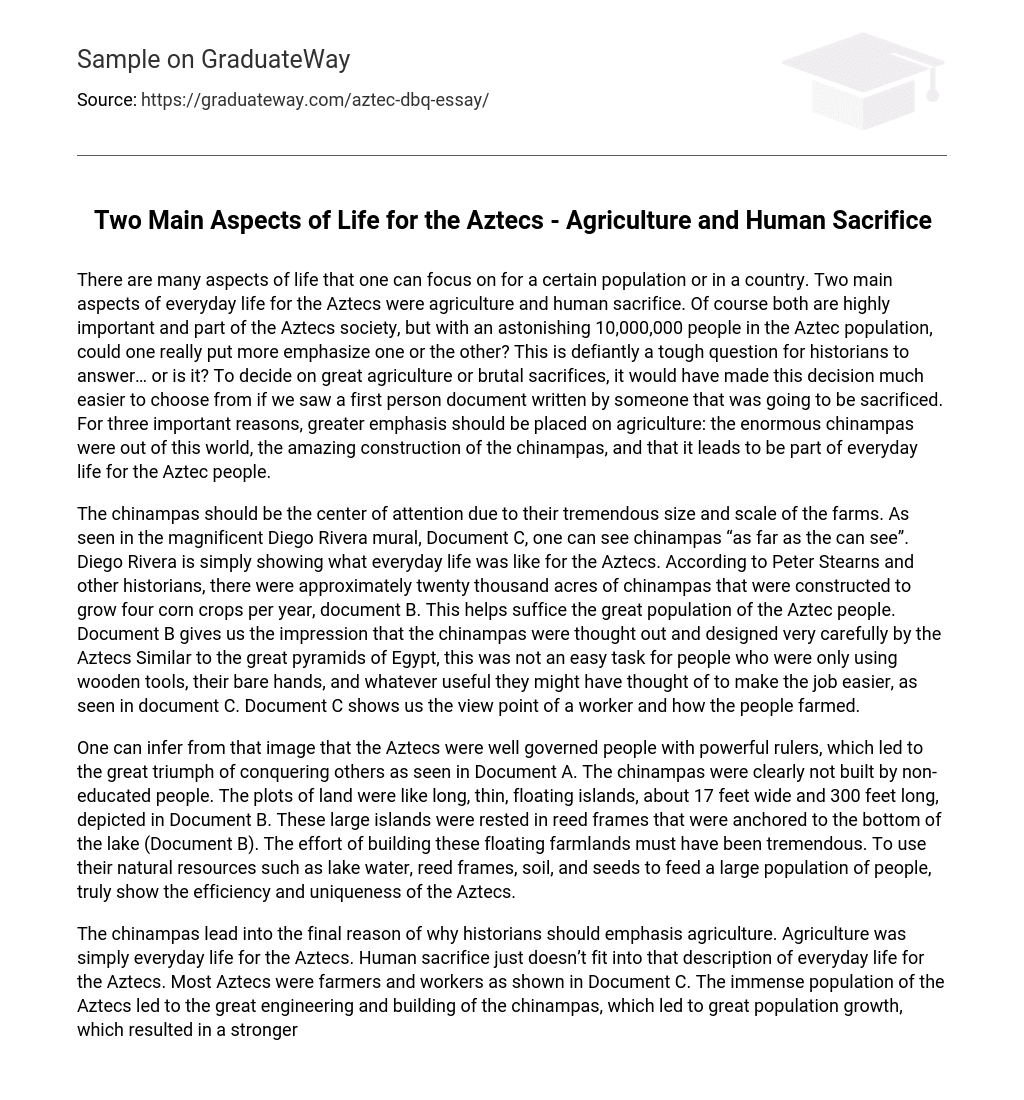The Aztecs had two significant aspects of everyday life – agriculture and human sacrifice. Both were highly important and integral to Aztec society. However, with a population of 10,000,000 people, it becomes challenging to prioritize one over the other. Historians often ponder on this dilemma. To make an informed decision between great agriculture or brutal sacrifices, it would have been helpful to have a first-person document from someone who was going to be sacrificed. Nevertheless, there are three compelling reasons why agriculture deserves greater emphasis: the astonishing chinampas system, the remarkable construction of chinampas, and its pervasive influence on Aztec people’s everyday lives.
The focus should be on the immense size and scale of the chinampas farms. Diego Rivera’s mural, Document C, displays the chinampas stretching as far as the eye can see, giving us a glimpse into Aztec daily life. Historians, including Peter Stearns, estimate that around twenty thousand acres of chinampas were built to produce four corn crops annually, as shown in document B. This allowed the Aztec population to be sustained. Document B also demonstrates that the Aztecs meticulously planned and designed the chinampas, similar to how the pyramids of Egypt were constructed. Despite using only wooden tools and their hands, the Aztecs found innovative ways to make farming more efficient, as depicted in document C. Through this document, we gain insight into the perspective of a worker and their agricultural practices.
It can be inferred from the image that the Aztecs were a well-governed civilization with powerful leaders, which resulted in their successful conquest of other peoples, as shown in Document A. The construction of the chinampas indicates that they were not built by uneducated individuals. These plots of land were long and thin, resembling floating islands that were approximately 17 feet wide and 300 feet long, as depicted in Document B. These large islands were supported by reed frames that were anchored to the lake’s bottom, as described in Document B. The effort required to construct these floating farmlands must have been significant. The Aztecs’ ability to utilize their natural resources such as lake water, reed frames, soil, and seeds to sustain a large population demonstrates the efficiency and uniqueness of their civilization.
The chinampas were a significant factor that historians should prioritize when discussing agriculture because it was a part of everyday life for the Aztecs. The Aztecs were primarily farmers and workers, as evidenced in Document C. The population growth of the Aztecs, fueled by the engineering and construction of the chinampas, contributed to the expansion and conquest of present-day Mexico.
Human sacrifice is an undeniable aspect of Aztec culture, as evidenced by the shocking and disturbing depictions shown in Document D. However, it is important to note that this social and open practice of sacrifice was not considered a negative thing, but rather a great honor, as explained in Document E. In Document D, Friar Diego Duran provides an explanation of the typical process of a sacrifice. Document E, on the other hand, presents the perspective of Friar Bernardino de Sahagun on the experience of witnessing a sacrifice from the beginning of the year. The warrior being sacrificed is treated as a deity, and the Aztecs are captivated by him. However, the drawback is that this revered “god” is ultimately sacrificed to the actual gods. Document D reveals that sacrifices could involve an astonishing number of men, reaching as high as 2,300. It is important to recognize that this gruesome Aztec tradition does not accurately depict the everyday lives of most Aztecs.
To fully understand the Aztecs, one must consider not only their practice of human sacrifice but also their daily activities such as farming, harvesting, and working in the grand chinampas. While human sacrifice is undoubtedly significant, it is impossible to comprehend the Aztec civilization without acknowledging the importance of their irrigation systems and agriculture. Hence, instead of placing emphasis on human sacrifice, historians should highlight the successful farming practices of the formidable Aztec civilization.





